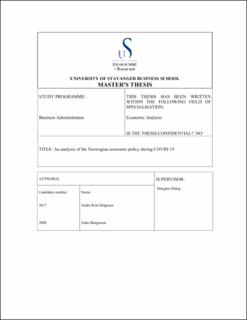| dc.description.abstract | This paper discusses the impact of COVID-19 on the Norwegian economy in the short, medium,
and long term. Moreover, it will discuss and analyze the economic policy response and its
effects. In addition, we will look at Norway in comparison with the rest of the world, primarily
other OECD countries.
The motivation for this is gaining perspective for the unique situation we are in and how it may
affect the future. COVID-19 affects day-to-day lives unlike any previous recessions in modern
times, and while most countries have taken on debt, Norway can fall back on transfers from the
Government Pension Fund Global. Therefore, it is highly relevant to look closer at how the
pandemic impacted the Norwegian economy and discuss how economic policy handled the
turbulence. For this purpose, we will discuss the impact and economic policy response from the
first quarter of 2020 until the end of the first quarter of 2021.
We will primarily look at how the real economic variables were hit when analyzing the impact.
The real economic variables involve the variables that affect Norway's GDP in aggregate form.
We will also discuss potential long-term consequences as a result of the pandemic. To do so, we
will look at consequences for long-term trend growth on output and regulations of the economic
framework. By this, we mean covering the most important factors of the Norwegian economy.
This will lay a good foundation to clarify and discuss the economic-political response. In that
way, we will cover monetary policy, fiscal policy, and the interaction between them.
The basis for the economic policy framework is established in chapter 2. We provide the theory
that is used for discussing and analyzing the economic response here. For monetary policy,
Norges Bank's flexible inflation targeting is used as a basis. This involves Norges Bank
stabilizing inflation near the target in the medium term. Flexible inflation targeting implies that
the central bank weighs stable inflation against the developments in output and demand. A model
established by Røisland and Sveen (2018) will be used for the monetary policy analysis.
When it comes to fiscal policy, Norway is in a unique position due to the oil fund. The usage of
oil revenues and fiscal policy's influence on aggregate output is crucial for this part of the paper. 3
Moreover, the potential effects of increased public spending are covered. Lastly, the chapter
covers the interaction between fiscal and monetary policy.
Chapter 3 starts with a presentation of how the impact and responses of COVID-19 around the
world were. Further, we cover how the world's economies are connected and how it affects
Norway. The chapter continues and ends with data and economic responses from the real
economy, inflation, the labor market, and the foreign exchange market.
In chapter 4, we discuss and analyze the economic policy response. We cover Norges Bank's
assessments and its rate decisions from the first quarter of 2020 until the first quarter of 2021.
Further, we assess this against the model we established in chapter 2 and compare this to other
OECD countries. Additionally, we discuss how the credit market was impacted.
In the next part of the chapter, we discuss the role of fiscal policy during the pandemic and
which long-term consequences it faces. We then discuss how the balance between monetary- and
fiscal policy is crucial and how the roles have changed since the financial crisis. We end the
chapter with a discussion of the long-term development and structural changes.
Finally, chapter 5 concludes the paper. | |
